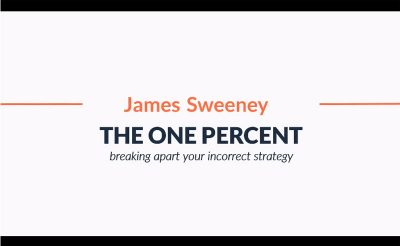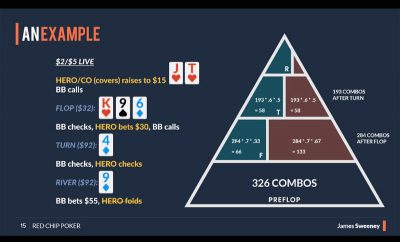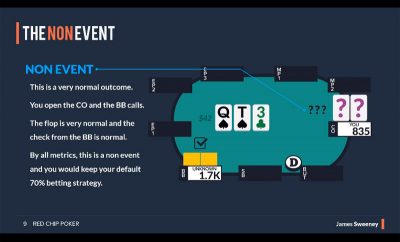If you’re looking for a good theoretical poker course that’s not too complicated but presents an effective and manageable approach to the game, SplitSuits’ The One Percent might just be the answer.
The course itself contains ten video lessons and a bonus video with questions and answers. It is taught by James “SplitSuit” Sweeney but it’s not something he came up on his own. Instead, it is a course based on Ed Miller’s book of the same name.

The way Sweeney envisioned his The One Percent course is for it to act as a companion of sorts for those who read the poker book on this topic. Although you can get a lot of great information from the videos alone, it works best if you actually watch it after reading the book or combine the book with video lessons.
The course itself presents an interesting and unique approach to poker in general. It isn’t focused on any particular segment (cash games, tournaments, sit and go’s, etc.). Ideas and concepts discussed inside can be applied to all forms of Hold’em games.
Table Of Contents
- So, What is The One Percent All About?
- What's Wrong With Your Current Strategy?
- Presenting the New Approach
- Expanding the Fundamentals
- Practical Application
- Balancing Out Bluffs & Value Bets
- Spotting & Exploiting Frequent Errors
- Learning to Recognize Key Events
- Thinking in Terms of Frequencies
- Raising & Dealing with Raises
- How To Get The One Percent Course
- Summary: How Good Is The One Percent, Really?
So, What is The One Percent All About?
When you observe poker from a theoretical point of view, there are different ways you can approach it. The one presented in the book and in the course is based on frequencies. This may suggest that this is a GTO course but it is not. While it is based on statistical and mathematical models, The One Percent presents ideas that are simpler to understand and easier to implement in your sessions while still helping you significantly improve your play.
When you play poker, certain things happen over and over again. You raise before the flop, you c-bet the flop, you’re faced with a 3-bet, etc. There are many such occurrences in poker and the strategy presented in this course revolves around understanding how often they happen and how you can respond to them accordingly.

While this is definitely a math-based course, Sweeney has done a great job introducing many examples (both from the book and fresh ones) to help learners visualize the stuff that are being discussed. This helps make the course much easier to keep up with and make most out of.
What's Wrong With Your Current Strategy?
The first video in The One Percent series deals with the very concept of frequencies and how you can use these to improve your game. It’s not just about recognizing these frequencies in your opponents. It is equally as important to look for them in your own play and fix any issues you come across along the way.
As SplitSuit explains, concepts in this course apply to tough and fishy games alike. While there may be different frequencies to look out for in different types of games, there are always certain things that you can recognize and take advantage of.
He gives a couple of examples that are quite common, especially in lower stakes games:
- Slot machiner – players that get involved with too many hands before the flop trying to hit a miracle hand and get paid.
- The TAG – players sticking to a very simple strategy of playing just good hands and giving up when faced with too much heat if they don’t have the goods.
The course uses these two examples to further break down the strategy. You can easily adjust to both of these types by following two simple rules:
- You should usually continue when your opponents bet
- When you bet on one street, you should usually bet on the next street
These rules make sense to some degree, but the question becomes – what does usually mean here? How do you turn the verbal expression into an actual number?
Presenting the New Approach
In the second video, Sweeney continues to expand on the strategic approach presented in The One Percent. After providing some general ideas about frequencies and how to use these to plan your strategy, this lesson starts to build an actual mathematical model that can be implemented into your game.
In this lesson, you’ll learn how the 70% model works in practice. It is founded on the idea that you should be continuing with about 70% of your range on every street. At the first glance, it may sound confusing and even fishy. However, after watching the video and seeing the visual representation of the model in the form of a pyramid, you’ll start to understand what it’s alla bout.

The video also explains how you can take advantage and exploit those players who don’t adhere to the model. You’ll notice how the edges of the pyramid become jagged for these players, leaving them vulnerable. If, for example, they’re folding too much on a particular street, you can bluff them with impunity. If they’re taking close to 100% of their turn range to the showdown, you can be much more liberal with your value bets.
Expanding the Fundamentals
The first two videos focus on the basics of the idea and the fundamental underlying model. However, so far in the course, all examples suppose there is no initiative change at any point during a hand. This isn’t how things actually work in poker, though. Initiative often changes and the aggressor can easily become the defender and vice-versa.
SplitSuit addresses this very important topic in detail using the same fundamental principles already explained in the course. He explains how it is important to build your range in a way that you have two pyramids for two different scenarios. In the event the initiative changes, you want to have another pyramid ready but built in a way that allows you to stick to the 70% model.

The way to achieve this is through the balance. You don’t want all your strong hands in one pyramid and all your weaker hands in the other. This will make it very hard to continue on the later streets. Instead, you need to mix things up so to keep both of them well-balanced.
This may seem complex and it is to some degree. However, things are made easier to understand through some examples. Additionally, Sweeney emphasizes the importance of understanding the overarching idea of these principles. If you can do this, the rest will fall in place on its own as you play more hands and analyze your play by applying these principles.
It’s important to mention that Sweeney admits this isn’t the optimal strategy that you must adhere to 100% of the time. It is envisioned as a solid foundation that you can always revert back to in tough spots. Of course, you can and should adjust your play according to particular circumstances.
Practical Application
This video takes everything that’s been discussed thus far in The One Percent course and tries to put it in a more concrete framework. If you aren’t too experienced of a player, you might be wondering what does this 70% even mean.
You’ll get your answers in this video.
Using several examples, SplitSuit explains with how many hands you should be continuing with and this may feel fishy at first. There are some hands that you’ll see that you might never consider in certain spots. But that’s the whole point of this course.
The idea of The One Percent is to teach you that you don’t want to be giving up on too many hands too easily. This will make you much harder to play against and will turn you into a much more profitable player.
And if you’re wondering how this makes you any different than a fishy player who almost never folds, Sweeney offers a very good explanation for this as well. By building a solid starting range and not getting involved with trash hands to begin with, you’re creating a situation where you can actually adhere to the 70% model and be right most of the time. Bad players get involved with all sorts of random hands and that’s where they make a cardinal mistake that leads them down the rabbit hole.
Balancing Out Bluffs & Value Bets
When you find yourself up against good players, you can expect they’ll be paying a close attention to what you’re doing and adjust their play accordingly. So, to avoid becoming transparent and ensure you’re not the one being exploited, you need to find a good balance between your value bets and bluffs.

Once again, the answer to this problem is found in frequencies.
In this video, Sweeney provides some solid numbers you can use as a baseline for your bluff vs. value bet ratio. He also explains how to build your ranges and polarize them more as you move on to the later streets.
Spotting & Exploiting Frequent Errors
One of the biggest advantages of adopting the approach presented in The One Percent resides with the fact that most players don’t really understand frequencies. Many of them make certain mistakes over and over again and this video provides some of the most common situations where frequency errors occur, such as:
- Static high card flops
- River raising
- Small sizes
- Top pair scenarios
- Monotone boards
SplitSuit goes through each of these scenarios and explains the main reasons behind mistakes. This is one of the better videos in the whole series as it will help you put things into perspective and give you a chance to figure out if you’re the one making mistakes in some of these situations.
You’ll also be given tools to fix these mistakes and take advantage of them when you recognize them in other players. This knowledge should put you well ahead a large percentage of the players in almost all games.
Learning to Recognize Key Events
Several times throughout the series you’ll hear the frequencies explained in the lessons are to be used as a baseline but you are supposed to deviate from them every now and then. If you were wondering how to recognize the spots where you should adjust your play, this video provides an in-depth explanation.

Sweeney breaks all possible events at a poker table into three main categories:
- Non-events, common, normal events that don’t really call for any changes
- Bad events – something happening that you don’t want to – i.e. button calling your raise instead of going HU vs. blinds (calling for lowering the frequencies)
- Good event – such as favorable flop texture –where you should increase your frequencies
Recognizing these events is very important. However, it is even more important to be able to plan for them ahead of time. This, of course, takes some time and practice, but once you are able to do it, you’ll be able to plan your entire hand even before any of these events actually happen.
Thinking in Terms of Frequencies
All of the ideas discussed so far are relevant with regards to hands you actually choose. The One Percent course is focused on wider ideas so you aren’t given exact hand charts to follow. Instead, it encourages you to think in broader terms.
In this particular video, you’ll learn how to think about hands from the frequency perspective. It will open your eyes to some possibilities you may not have been aware of and it may even help dispel some myths about bluffing and value betting in certain spots.
Raising & Dealing with Raises
The final two videos in the Red Chip Poker The One Percent series deal with raises. These lessons discuss situations where you should consider raising instaead of calling as well as those spots where you bet and are faced with a raise.
The basic strategy starts from the main principle of making sure you’re continuing often enough (i.e. 70%). From there on, you can start thinking about how to build your raising ranges and your defending ranges in the spots where you’re the one facing the raise.

Like the rest of the series, these two videos come up with some ideas that may seem strange at first. Overall ranges that Sweeney suggests may seem way too wide in certain spots but if you’ve been keeping up with the materials discussed up to this point, you’ll understand where these ideas come from and why they work.
How To Get The One Percent Course
You can pick up the One Percent course in two ways:
- As a standalone course from SplitSuit which you can do right here for $199 for the basic edition or $399 for the pure addition.
- As part of the RedChipPoker Pro package which costs $50 per month but includes a lot of other content. You can read more on our the RedChipPoker Pro package in our more detailed review.
There is no difference in the actual course content depending on where you get it, however, you might want to consider if you want to have lifetime access to the content? If so well then you would be better off buying as a standalone product from SplitSuit.
Alternatively, you might be intending on doing a lot of study over the coming months and years for which the RedChipPoker Pro package would be be a better fit.
Summary: How Good Is The One Percent, Really?
One of the biggest values of The One Percent is the fact the approach it takes is not something you’ll find in many other courses. Ed Miller’s ideas expanded and explained by Sweeney represent an interesting approach to the game that’s close to GTO in some of its aspects but it is much more tangible and easier to digest.
This course can be very valuable to almost all players looking to add some structure to their game. Unless you’re already a winner at high stakes, you’ll probably find quite a few interesting ideas and concepts in The One Percent.
All in all, while it may be a bit out there, this course is definitely worth watching. It will give you a fresh perspective of poker and provide you with an approach that you just couldn’t stumble upon yourself. And if you give it enough time, you’re quite likely to realize advantages of this approach and start implementing at least some of its aspects into your gameplan.
